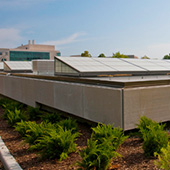Evaluating energy: NU gets a checkup
 Northwestern University has a sizable energy appetite; practically a small city, the 206 buildings on the Evanston Campus alone consume more than 170 million kilowatt hours of electricity and more than 12 million therms of natural gas for heating and cooling. At the heart of all this is Northwestern’s Central Utility Plant (CUP), that unobtrusive little workhorse that sits to the East of Swift Hall near the pond and Main Library. You could say that CUP is the heart of Evanston's Campus; pumping steam and chilled water through the University’s circulatory system to provide heating and cooling as far North as SPAC and as far South as Crown Hall. Like anything vital to the health of the University, NU’s Facilities Management team has been hard at work; looking for opportunities to make our system, the heart, arteries, and veins, as efficient as possible. This means finding ways to improve the health of the system: to deliver energy efficiently, to conserve energy where it’s used, and to make sure that the heart itself, CUP’s four boilers and five chillers, are being run effectively.
Northwestern University has a sizable energy appetite; practically a small city, the 206 buildings on the Evanston Campus alone consume more than 170 million kilowatt hours of electricity and more than 12 million therms of natural gas for heating and cooling. At the heart of all this is Northwestern’s Central Utility Plant (CUP), that unobtrusive little workhorse that sits to the East of Swift Hall near the pond and Main Library. You could say that CUP is the heart of Evanston's Campus; pumping steam and chilled water through the University’s circulatory system to provide heating and cooling as far North as SPAC and as far South as Crown Hall. Like anything vital to the health of the University, NU’s Facilities Management team has been hard at work; looking for opportunities to make our system, the heart, arteries, and veins, as efficient as possible. This means finding ways to improve the health of the system: to deliver energy efficiently, to conserve energy where it’s used, and to make sure that the heart itself, CUP’s four boilers and five chillers, are being run effectively.
As a part of this effort NU has engaged the world’s leading engineering firms to evaluate alternative technologies that could improve and supplement CUP, such as solar photovoltaic, geothermal heating and cooling, wind energy generated offsite, and cogeneration (cogen), or combined heat-and-power.
After a thorough analysis, some technologies have emerged as winners in terms of economic and environmental impacts. “We looked at a variety of technologies in isolation and in combination and at scale, cogeneration just makes the most sense for reducing our utility cost and our greenhouse gas emissions,” said NU’s Director of Sustainability, Rob Whittier.
Cogeneration is the use of a turbine to simultaneously generate electricity and useful heat. Northwestern already has a highly-efficient Central Utility Plant (CUP) which utilizes boilers, steam, and electrically driven chillers to provide heating and cooling (through steam and chilled water) to a majority of NU’s facilities in Evanston. Cogeneration would mean adding a gas turbine to generate electricity, meeting as much as 50 percent of the Evanston campuses electricity demand and producing highly efficient steam for heating and cooling.
Conventional central coal or nuclear-powered power stations convert roughly 33 percent of their input heat to electricity. The remaining 67 percent of energy from the turbines is wasted. If you’ve ever seen a cooling tower billowing steam, you’ve seen this in action. Cogeneration plants are designed to use almost all of this waste heat resulting in much higher efficiency and substantial financial and environmental benefits. By generating power at CUP, near the point of use, NU will be able to provide efficient and reliable power to critical research and academic buildings!
Cogeneration can be very beneficial in natural disaster situations, for example in 2012, when super-storm Sandy ravaged the east coast, Princeton University, which operates a 15 Megawatt (MW) cogeneration plant, was able to continue to power its entire campus for four days.
So are new technologies such as geothermal, wind, and cogeneration in NU's future? While there are many potential benefits, both economically and environmentally, it’s not a decision to be made lightly. For example, the cost of natural gas and electricity can have a significant impact on the viability of clean energy alternatives and forecasting either can be difficult. But early studies clearly suggest that some of these options are viable and NU is currently reviewing the results with experts with the hopes of a decision by this winter.